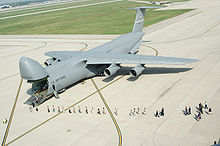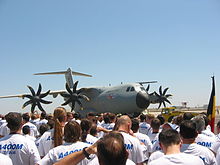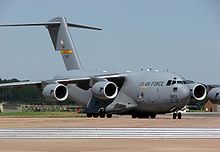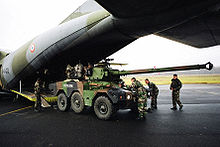- Airlift
-
For other uses, see Airlift (disambiguation).The Airbus A400M, the future transport/tanker aircraft of many European countries

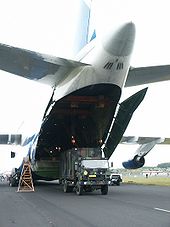 Antonov An-124 loading a container for the Dutch military
Antonov An-124 loading a container for the Dutch military
An airlift is the organized delivery of supplies or personnel primarily via aircraft.
Airlifting consists of two distinct types, strategic and tactical airlifting. Typically, strategic airlifting involves moving material long distances (such as across or off the continent or theater), whereas a tactical airlift focuses on deploying resources and material into a specific location with high precision.
Depending on the situation, airlifted supplies can be delivered by a variety of means. When the destination and surrounding airspace is considered secure, the aircraft will land at an appropriate airport or airbase to have its cargo unloaded on the ground. When landing the craft, or distributing the supplies to a certain area from a landing zone by surface transportation is not an option, the cargo aircraft can drop them in mid-flight using parachutes attached to the supply containers in question. When there is a broad area available where the intended receivers have control without fear of the enemy interfering with collection and/or stealing the goods, the planes can maintain a normal flight altitude and simply drop the supplies down and let them parachute to the ground. However, when the area is too small for this method, as with an isolated base, and/or is too dangerous to land in, a Low Altitude Parachute Extraction System drop is used.
Contents
History
In April 1923 aircraft of the RAF's Iraq Command flew 280 Sikh troops from Kingarban to Kirkuk in the first British air trooping operation. This operation was only conducted over a short range and it was not until 1929 that the RAF conducted a long-range non-combat air evacuation of British diplomatic staff from Afghanistan to India during the Kabul Airlift.
The world's first long-range combat airlift took place in July 1936.[1] Luftwaffe Ju 52 and Italian Air Force Savoia-Marchetti SM.81 were used by the Spanish Nationalists to transport troops from Spanish Morocco to Spain at the beginning of the Spanish Civil War.
Airlifts became practical during World War II as aircraft became large and sophisticated enough to handle large cargo demands. The USAAF began the largest and longest-sustained airlift of the war in May 1942, delivering more than half a million net tons of materiel from India to China over the Hump by November 1945. That operation by the Air Transport Command presaged the even larger Berlin airlift, lasting from June 1948 to September 1949, an American, British and French operation intended to thwart the blockading of the city of Berlin by the Soviet Union.
Strategic airlift
Strategic airlift is the use of cargo aircraft to transport materiel, weaponry, or personnel over long distances. Typically, this involves airlifting the required items between two airbases which are not in the same vicinity. This allows commanders to bring items into a combat theater from a point on the other side of the planet, if necessary. Aircraft which perform this role are considered strategic airlifters. This contrasts with tactical airlifters, such as the C-130 Hercules and Transall C-160, which can normally only move supplies within a given theater of operations.
Examples of strategic airlifters include:
 /
/ Antonov An-124 'Ruslan'
Antonov An-124 'Ruslan' Boeing C-17 Globemaster III
Boeing C-17 Globemaster III Ilyushin Il-76 'Candid'
Ilyushin Il-76 'Candid' Lockheed C-141 Starlifter
Lockheed C-141 Starlifter Lockheed C-5 Galaxy
Lockheed C-5 Galaxy
The United States has by far the greatest strategic airlift capacity of any nation in the world.[citation needed] Many countries' armed forces possess little or no strategic airlift capacity, preferring to lease from private-sector firms as needed.[citation needed] Alternatively, groups of nations - especially within formal alliances such as NATO - may choose to pool their strategic airlift resources rather than individually duplicating the substantial investment required to purchase and maintain such costly and, in many cases, seldom-used assets.
That being said, with present technology it is impossible even for the United States to shift a substantial mechanised force, particularly tanks, by air. This difficulty has prompted investment from the US military in lighter armoured fighting vehicles (such as the Stryker), as well as some preliminary research into alternative airlift technologies such as ekranoplan-style planes and airships.
Tactical airlift
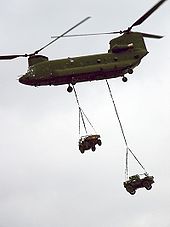 CH-47 Chinook demonstrating airlift capabilities
CH-47 Chinook demonstrating airlift capabilities
Tactical airlift is a military term for the airborne transportation of supplies and equipment within a theatre of operations (in contrast to strategic airlift). Aircraft which perform this role are referred to as tactical airlifters. These are typically turboprop aircraft, and feature short landing and take-off distances and low-pressure tyres allowing operations from small or poorly-prepared airstrips. While they lack the speed and range of strategic airlifters (which are typically jet-powered), these capabilities are invaluable within war zones. Larger helicopters such as the CH-47 Chinook and Mil Mi-26 can also be used to airlift men and equipment. Helicopters have the advantage that they do not require a landing strip and that equipment can often be suspended below the aircraft allowing it to be delivered without landing but are highly inefficient.
Tactical airlift aircraft are designed to be maneuverable, allowing low-altitude flight to avoid detection by radar and for the airdropping of supplies. Most are fitted with defensive aids systems to protect them from attack by surface-to-air missiles.
The earliest Soviet tactical airlift occurred in 1929[citation needed], in which forty men of the Red Army were airlifted to the town of Garm, Tajikistan (then the Tajik Soviet Socialist Republic) to repel an attacking force of Basmachi rebels under Fuzail Maksum.
Examples of tactical airlifters include:
 Airbus A400M (Under Development.)
Airbus A400M (Under Development.) /
/ Antonov An-12 'Cub'
Antonov An-12 'Cub' /
/ Antonov An-70
Antonov An-70 Boeing C-17 Globemaster III
Boeing C-17 Globemaster III /
/ CASA CN-235
CASA CN-235 EADS CASA C-295
EADS CASA C-295 /
/ Lockheed Martin/Alenia C-27 Spartan
Lockheed Martin/Alenia C-27 Spartan Lockheed Martin C-130 Hercules
Lockheed Martin C-130 Hercules /
/ Transall C-160
Transall C-160 Kawasaki C-X (Under Development.)
Kawasaki C-X (Under Development.) Shaanxi Y-9 (Under Development.)
Shaanxi Y-9 (Under Development.) Embraer KC-390 (Under Development.)
Embraer KC-390 (Under Development.) /
/ Indo-Russian Transport Aircraft (Under Development.)
Indo-Russian Transport Aircraft (Under Development.) Lockheed C-141 Starlifter
Lockheed C-141 Starlifter
Note: The Airbus Military A400M, a tactical airlifter, blurs the line between tactical and strategic transports. Airbus stresses its tactical performance but also its strategic capabilities; higher payload, higher range and higher speed than the Hercules, although not as high as the C-17. The table below demonstrates this status, the A-400 occupying a "middle ground" between the C-130 and the C-17.
Performance comparison
Aircraft Role Max. payload Range (w/max) Cruise Ceiling Price  Embraer KC-390
Embraer KC-390Tactical 52,029 lb (23,600 kg) 2,924 NM (5,417 km) Mach .70 36,000 ft $ 50m (est.)  /
/ An-12
An-12Tactical 44,090 lb (20,000 kg) 1,940 NM (3,600 km) Mach .55 33,000 ft —  C-130J[2]
C-130J[2]Tactical 41,790 lb (18,955 kg) 2,380 NM (4,400 km) Mach .58 33,000 ft $ 70m (est.)  Airbus A400M
Airbus A400MTactical/strategic 81,500 lb (37,000 kg) 2,450 NM (4,540 km) Mach .72 37,000 ft € 100m (est.)  Kawasaki C-2
Kawasaki C-2Tactical 82,800 lb (37,600 kg) 3,000 NM (5,600 km) Mach .80 40,000 ft —  /
/ Antonov An-70
Antonov An-70Tactical/strategic 103,620 lb (47,000 kg) 1,621 NM (3,000 km) Mach .73 40,000 ft $ 80m (est.)  /
/ IL-76MF
IL-76MFStrategic/tactical 132,300 lb (60,000 kg) 2,159 NM (4,000 km) Mach .70 42,700 ft $ 50m (est.)  C-17
C-17Strategic/tactical 170,900 lb (77,520 kg) 2,800 NM (5,200 km) Mach .77 45,000 ft $ 202.3m  C-5 Galaxy
C-5 GalaxyStrategic 270,000 lb (122,472 kg) 2,400 NM (4,440 km) Mach .77 34,000 ft $ 168m  /
/ /
/ An-124
An-124Strategic 330,000 lb (150,000 kg) 2,900 NM (5,400 km) Mach .65 35,000 ft $ 70-100m  /
/ An-225
An-225Strategic 551,000 lb (250,000 kg) 2,159 NM (4,000 km) Mach .61 33,000 ft — See also
- Airbridge
- Airdrop
- Air cargo
- Berlin airlift
- Loss of Strength Gradient
- Power projection
- Sealift
References
- ^ Per photograph caption pg.146 and also text pg.201, Air Power, Budiansky, Stephen, Penguin Group, London England 2005
- ^ C-130J specifications
Categories:- Airlifts
Wikimedia Foundation. 2010.

